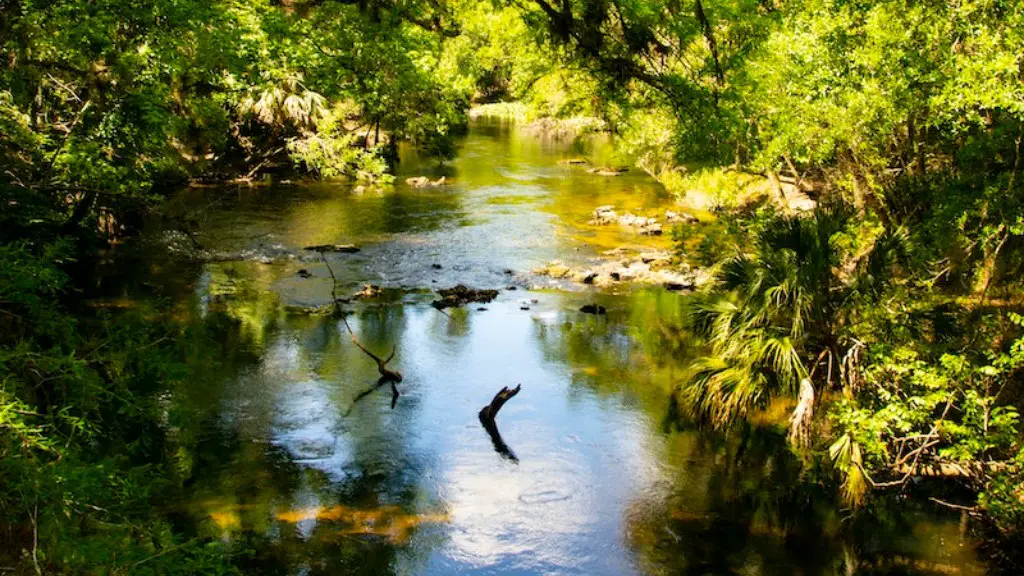The Source and Mouth of the Mississippi River
The Mississippi River is one of the most iconic waterways in the United States, and its source and mouth have significant historical and environmental importance. According to the United States Environmental Protection Agency, the source of the Mississippi River is located in Lake Itasca in northern Minnesota. The lake is fed by numerous tributaries and its waters travel more than 2,500 miles before reaching the mouth at the Gulf of Mexico in southeastern Louisiana. Throughout its journey, the Mississippi River forms the border between 10 U.S. states, promotes navigation and transportation, and provides certain species of fish, birds, and mammals with essential habitat. In turn, the river provides people with recreational opportunities, such as fishing and boating.
Geographers and hydrologists have studied the Mississippi River extensively throughout history and sought to explain the phenomenon of its source and mouth. Experts in the field have identified three main sources of the river’s water, which includes precipitation, runoff from rivers and streams, and underground aquifers. Hydrogeologists have studied the chemistry and flow of the Mississippi River’s water to better understand how these three sources contribute to its flow. Most of the water in the river is related to precipitation that occurs in the St. Anthony Falls region and upstream. In contrast, the contribution of groundwater is higher in the southern and western regions.
The Mississippi River is particularly important to human life in the United States due to its sheer size and the numerous benefits it provides. Historically, the river’s impact has been profound and its importance has changed over time. In the 19th century, the Mississippi River was the foundation of a thriving commercial and industrial economy that sustained much of the population along its banks. By the late 20th century, the river had been heavily regulated for navigation and flood control purposes. Today, the Mississippi River serves as a major transportation conduit, providing cities, such as Memphis and New Orleans, with high-volume shipping of commodities and cargo.
The environmental significance of the Mississippi River is also a key factor to consider. The river’s expansive floodplain provides a unique habitat for plants and animals, providing each species with the resources necessary to survive and thrive. Each year, more than 250 species of birds use the river, along with 230 types of fish. The Mississippi River Basin is also home to many threatened and endangered species, such as the American alligator, the pallid sturgeon, and the piping plover. Being the largest river system in North America, the Mississippi River is essential to a healthy and diverse ecosystem.
The river is also a major source of information on climatological and geological trends, enabling researchers to accurately monitor certain changes in the environment. For example, in 2011, the Mississippi River experienced unusual flooding that forced the U.S. Geological Survey (USGS) to construct the Upper Mississippi River National Wildlife and Fish Refuge. This refuge served as the first analysis of the upper Mississippi River basin, which is considered to be the largest river-floodplain ecosystem in the world and provides significant environmental benefits.
Finally, the mouth of the Mississippi River is particularly special to people living in Louisiana and other surrounding areas. The mouth of the river encompasses a complex network of landforms, including swamplands, wetlands, and natural estuaries known as bayous. The estuary of the Mississippi River Delta is a key habitat for numerous types of birds, fish and mammals, and is an integral part of the greater Gulf Coast ecosystem. The mouth and delta of the Mississippi River is also a major source of recreation for people living in surrounding states, offering boating, fishing, swimming, and other recreational activities.
The Mississippi River has been a major factor in human mobility throughout history, especially in regards to transportation and navigation. Estimates suggest that the river was used for navigation as far back as 5,500 years ago, when early inhabitants travelled on the river in handmade canoes. In the 19th century, the river came to be a major highway for transportation and commerce due to the technological advancements of steamboats. During this time, passengers and goods were transported up and down the river, increasing opportunities for trade and commerce.
Today, the Mississippi River remains an important factor in navigation, particularly with barges and towboats. According to the U.S. Army Corps of Engineers, approximately 600 million tons of cargo were shipped on the river in 2018, creating a total of $7.3 billion in economic activity. The river is also used by smaller vessels, including recreational boats, kayaks, and canoes. The numerous locks and dams along the river provide boats with safe navigation, making the river accessible to people from all walks of life.
The navigation of the Mississippi River is heavily regulated by the U.S. Army Corps of Engineers, a federal agency that is responsible for the river’s maintenance. According to the Corps, the primary goal is to create a “safe and commercially functioning waterway” for both commercial and recreational vessels. The Corps also works in partnership with many states to develop effective strategies for managing the river and its watershed, so that the river’s resources are used in a sustainable manner.
The regulation of the Mississippi River is largely directed by the 200-year-old U.S. Imnav Act. The Act requires that all large vessels navigating the river adhere to certain standards, such as speed and size. To this end, the Act also establishes rules for large vessels, including the establishment of designated navigation channels, limited passing zones, and vessel piloting requirements. In recent years, these standards have been updated in order to meet the needs of the changing river environment.
The navigation of the Mississippi River has a long and interesting history, and has continually evolved throughout the years. The river’s importance to transportation, commerce, and recreation are key components of its success, and the success of its management organizations. In recent years, there has been a focus on improving the navigation of the river and increasing access for both commercial and recreational vessels. As the Mississippi River continues to be an integral part of American culture, proper management and regulation of the river’s navigation will remain a top priority.
The Impact of the Mississippi River on People
The impact of the Mississippi River on people has been profound throughout history, especially in regards to ecology and economy. In terms of ecology, the river provides habitats for numerous species of mammals, birds, and fish. It also provides people with access to natural resources, such as timber and minerals, as well as an important source of food and recreation. As for economy, the Mississippi River serves as a major transportation route for freight and other commodities, allowing people to travel between cities and states with ease. As the river continues to be a source of wealth, sustainability and resource conservation are increasingly important considerations.
The presence of the Mississippi River has also been influential for Native American communities. For example, the river served as a major transportation route for many tribes, providing access to resources and opportunities for trade. Today, many Native Americans live in or near the Mississippi River basin, and continue to rely on the river for physical and spiritual sustenance. The Native Americans’ close relationship with the river has also been influential in terms of ecology, culture, and economy.
In terms of economy and culture, the Mississippi River has had a major impact on communities throughout the region. The river and its tributaries provide cities, such as Memphis and New Orleans, with a certain level of economic prosperity, as well as a unique cultural identity. This identity is reflected in the music, food, and art of the region, and is celebrated for its unique cultural fusion. Additionally, many of the historic sites along the Mississippi River serve as a testament to its history and importance.
The Mississippi River is also important to people in terms of recreation. From kayaking and rafting to skiing and hunting, the river provides numerous recreational opportunities throughout the entire year. The river is also a source of spiritual nourishment for many of its inhabitants, providing both recreation and an emotional connection to the natural world.
The Mississippi River has been a source of life and prosperity for millions of people throughout history. Today, the river is still a major factor in many aspects of life, including ecology, economy, culture, and recreation. As the river continues to be a source of inspiration, education, and recreation, it is important that its resources are used in a sustainable and responsible manner.
Environmental Conservation of the Mississippi River
The welfare of the Mississippi River is critically important, and the U.S. government has taken a number of measures to ensure the long-term health and conservation of the river’s ecosystems and resources. In 1933, President Franklin D. Roosevelt established the Mississippi River Basin Commission (MRBC), a federal agency responsible for overseeing the river’s development and conservation. The MRBC is comprised of representatives from various states in the region, and is one of the primary organizations responsible for regulating and protecting the river.
The MRBC works in partnership with numerous organizations, such as the U.S. Army Corps of Engineers, The Nature Conservancy, and the Environmental Protection Agency, so that the river’s resources are managed in a responsible and sustainable manner. An important component of the MRBC’s efforts is its research initiatives, which focus on understanding the impacts of climate change, aquatic life, soil erosion, and other important aspects of river conservation.
In an effort to promote conservation, the MRBC and its partners have implemented a number of initiatives to protect the health of the river. Examples include the application of best management practices to farming and forestry, the restoration of riverbanks and floodplains, and the protection of the river’s wetlands. In addition, the MRBC works to inform and educate the public on the importance of conservation and the consequences of over-utilization of the river’s resources. Public outreach initiatives include lectures, workshops, and various other forms of environmental education.
The Mississippi River is one of the most important ecosystems in the United States, and its conservation is integral to its sustainability. In order to promote the long-term health of the river, it is important that its resources are managed in a responsible manner. As such, government agencies, organizations, and individuals are working together to ensure that the river’s future is a bright one.
Mississippi River Shipping
The Mississippi River has been a key factor in human mobility throughout history, and is still a major transportation route for goods and commodities today. According to the American Waterways Operators, the river is used for the shipment of more than 600 million tons of cargo each year, providing economic benefits for thousands of communities along the river.
The main types of cargo shipped on the Mississippi River include oil and gas, grain, coal, and minerals. The majority of these goods are transported via barge, a type of cargo vessel that can be towed by tugboats. These vessels are commonly used due to their size and low cost of operation, and it is not uncommon to see hundreds of barges moving along the river at once.
The Mississippi River is also an essential factor in the transportation of certain commodities, such as petroleum and crude oil. According to the U.S. Energy Information Administration, approximately 70% of the crude oil shipped on the river is destined for refineries located along the Gulf Coast. This is due to the fact that the river is an essential shipping route for goods travelling between the Midwest and the Gulf Coast.
The importance of the river to shipping is also evident in its role in the import/export industry. Commercial vessels and barges are used for the transportation of chemicals, paper, plastics, cars, and other goods to and from the Midwest and other regions. Additionally, the river serves as a major source of employment for people from all walks of life, providing them with much-needed economic opportunities.
The Mississippi River is one of the most important transportation routes in the United States, and its importance has only grown over time. The river’s strategic location and its ability to accommodate large vessels make it an ideal shipping route, allowing for the efficient transportation of goods and commodities between the Midwest and the Gulf Coast. This, in turn, provides employment and economic opportunities for thousands of people.





